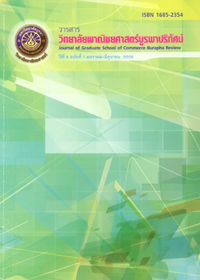โมเดลการกำหนดปริมาณการผลิตด้วยวิธีผสมผสานแนวคิดต้นทุนฐานกิจกรรม ตามเวลาและทฤษฎีข้อจำกัด
Main Article Content
Abstract
บทความนี้มีวัตถุประสงค์เพื่อนำเสนอโมเดลแบบผสมผสาน (Mixed-model) เพื่อใช้ตัดสินใจในการกำหนด ปริมาณการผลิตของสินค้า (Product-Mix) โดยบทความได้เสนอโมเดลใหม่นี้ทั้งในรูปตัวแบบเชิงวิเคราะห์ พร้อมทั้งตัวอย่าง ในการนำไปใช้ แนวคิดของโมเดลแบบผสมผสานนี้ พัฒนามาจากแนวคิดต้นทุนฐานกิจกรรมตามเวลา (Time-Driven Activity-Based Costing, TDABC) ร่วมกับทฤษฎีข้อจำกัด (Theory of Constraints, TOC) และระดับความสามารถในการ ควบคุมทรัพยากรการผลิต จากการศึกษาพบว่าสัดส่วนปริมาณการผลิตของสินค้าด้วยโมเดลแบบผสมผสานทำให้กิจการ มีกำไรสูงกว่าสัดส่วนปริมาณการผลิตของสินค้าด้วยวิธี TOC หรือ วิธี TDABC วิธีใดวิธีหนึ่งแต่เพียงอย่างเดียวหากกิจการ สามารถควบคุมระดับทรัพยากรการผลิตได้ในระดับที่สูง เนื่องจากโมเดลแบบผสมผสานได้กำหนดปริมาณการผลิตของ ผลิตภัณฑ์แต่ละชนิดโดยอาศัยข้อมูลเกี่ยวกับต้นทุนผลิตภัณฑ์ที่แม่นยำ ข้อมูลข้อจำกัดของทรัพยากรในการผลิต และ ระดับความสามารถในการควบคุมทรัพยากรการผลิต
THE PRODUCT-MIX MODEL: THE MIXED CONCEPTS OF TIME-DRIVEN ACTIVITY-BASED COSTING AND (TDABC), AND THEORY OF CONSTRAINTS (TOC), AND THE LEVELS OF CONTROL ON PRODUCTION
Prapaporn Kiattikulwattana
Accounting Department Chulalongkorn Business School, Chulalongkorn University, Bangkok 10330, Thailand
The purpose of this article is to introduce the new model, the mixed model, for product-mix decisions by exhibiting the analytical model and its example. The mixed model is based on the concepts of Time-Driven Activity-based Costing (TDABC), Theory of Constraints (TOC), and the levels of control on production resources. The product-mix solution from the mixed-model show highest profit if the company can control most of its production resources. The reason is that the mixed-model calculates the optimal product-mix quantity which is based on accurate product cost, constraints of production resources, and the levels of control on production resources.
Article Details
The owner of the article does not copy or violate any of its copyright. If any copyright infringement occurs or prosecution, in any case, the Editorial Board is not involved in all the rights to the owner of the article to be performed.


